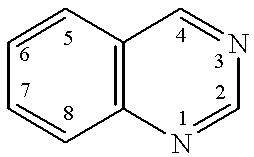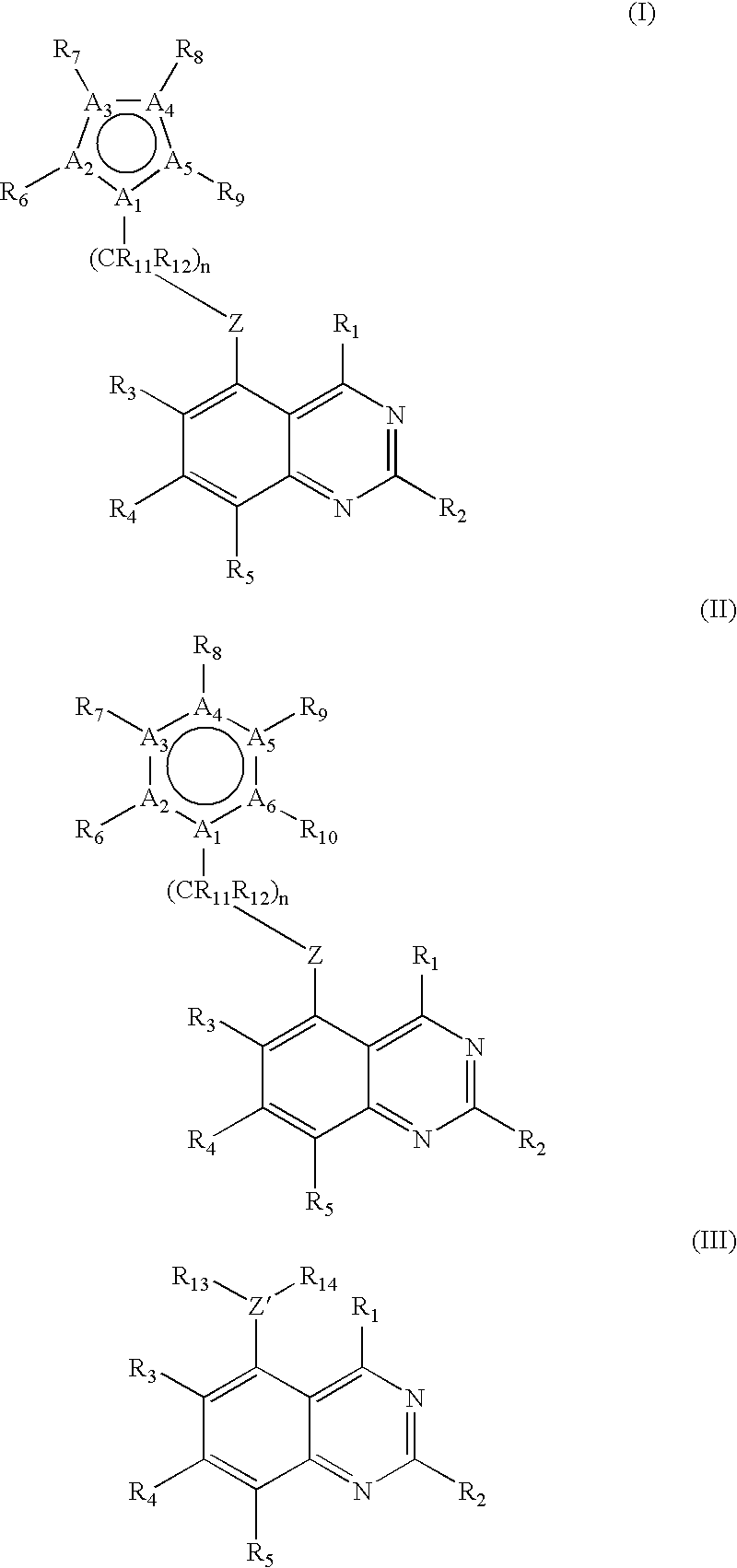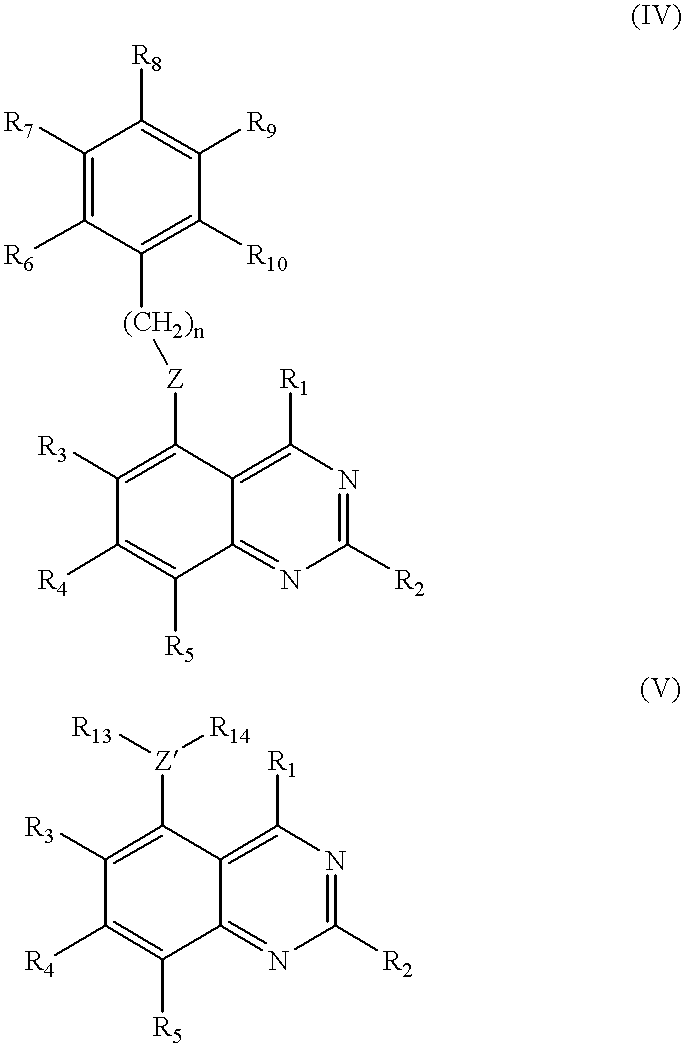Methods of modulating serine/threonine protein kinase function with quinazoline-based compounds
- Summary
- Abstract
- Description
- Claims
- Application Information
AI Technical Summary
Benefits of technology
Problems solved by technology
Method used
Image
Examples
example 1
Procedures for Synthesizing Quinazoline Compounds of the Invention
[0283]The quinazoline compounds of the invention were synthesized using procedures A, B, C, D, and E, as described below. These procedures were carried out using the following conditions, techniques, and methods for evaluation:[0284](i) evaporations were carried out by rotary evaporation in vacuo;[0285](ii) operations were carried out under an atmosphere of an inert gas such as nitrogen;[0286](iii) high performance liquid chromatography procedures (HPLC) were performed on Merck LiChrosorb RP-18 reversed-phase silica obtained from E. Merck, Darmstadt, Germany;[0287](iv) yields are given for illustration only and are not necessarily the maximum attainable;[0288](v) melting points are uncorrected and were determined using a HWS Mainz SG 2000 digital melting point apparatus;[0289](vi) the structures of all compounds of the formula (I), (II), and (III) of this invention were confirmed by proton magnetic resonance spectrosc...
example 2
Assay Measuring Phosphorylating Function of RAF
[0354]The following assay reports the amount of RAF-catalyzed phosphorylation of its target protein MEK as well as MEK's target MAPK. The RAF gene sequence is described in Bonner et al., 1985, Molec. Cell. Biol. 5: 1400-1407, and is readily accessible in multiple gene sequence data banks. Construction of the nucleic acid vector and cell lines utilized for this portion of the invention are fully described in Morrison et al., 1988, Proc. Natl. Acad. Sci. USA 85: 8855-8859.
Materials and Reagents
[0355]1. Sf9 (Spodoptera frugiperda) cells; GIBCO-BRL, Gaithersburg, Md.[0356]2. RIPA buffer: 20 mM Tris / HCl pH 7.4, 137 mM NaCl, 10% glycerol, 1 mM PMSF, 5 mg / L Aprotenin, 0.5% Triton X-100;[0357]3. Thioredoxin-MEK fusion protein (T-MEK): T-MEK expression and purification by affinity chromatography were performed according to the manufacturer's procedures. Catalog#K 350-01 and R 350-40, Invitrogen Corp., San Diego, Calif.[0358]4. His-MAPK (ERK 2); ...
example 3
Purification of MAPK and MEK
[0388]The MAPK and MEK proteins are readily expressed in cells by sublconing a gene encoding these proteins into a commercially available vector that expresses the proteins with a poly-Histidine tag. Genes encoding these proteins are readily available from laboratories that normally work with these proteins or by cloning these genes from cells containing cDNA libraries. The libraries are readily commercially available and a person skilled in the art can readily design nucleic acid probes homologous to cDNA molecules encoding MEK or MAPK from the nucleic acid sequences of MEK and MAPK, available in multiple gene data bases such as Genbank. The cloning of a gene can be accomplished in a short time period using techniques currently available to persons skilled in the art.
[0389]Purification of the MEK and MAPK proteins from cell extracts can be accomplished using the following protocol, which is adapted from Robbins et al., 1993, J. Biol. Chem. 268: 5097-5106...
PUM
| Property | Measurement | Unit |
|---|---|---|
| Molar density | aaaaa | aaaaa |
| Molar density | aaaaa | aaaaa |
| Molar density | aaaaa | aaaaa |
Abstract
Description
Claims
Application Information
 Login to View More
Login to View More - R&D
- Intellectual Property
- Life Sciences
- Materials
- Tech Scout
- Unparalleled Data Quality
- Higher Quality Content
- 60% Fewer Hallucinations
Browse by: Latest US Patents, China's latest patents, Technical Efficacy Thesaurus, Application Domain, Technology Topic, Popular Technical Reports.
© 2025 PatSnap. All rights reserved.Legal|Privacy policy|Modern Slavery Act Transparency Statement|Sitemap|About US| Contact US: help@patsnap.com



